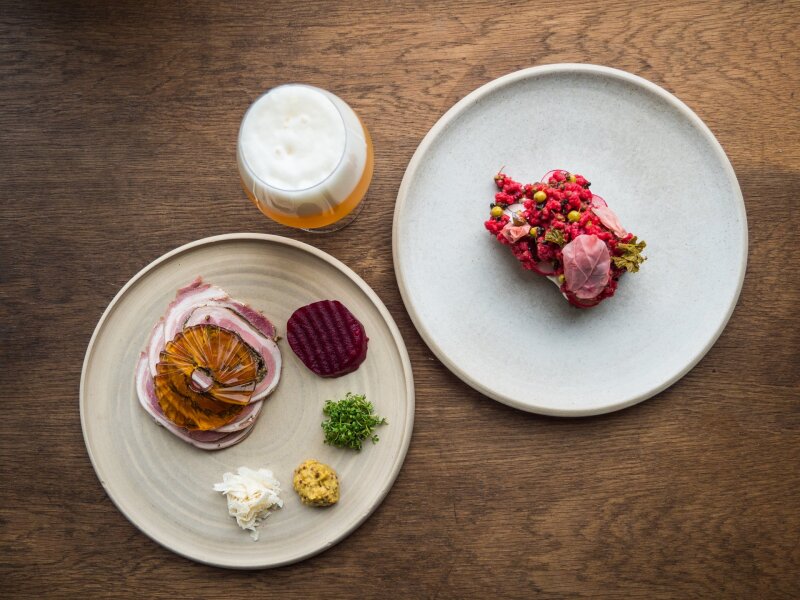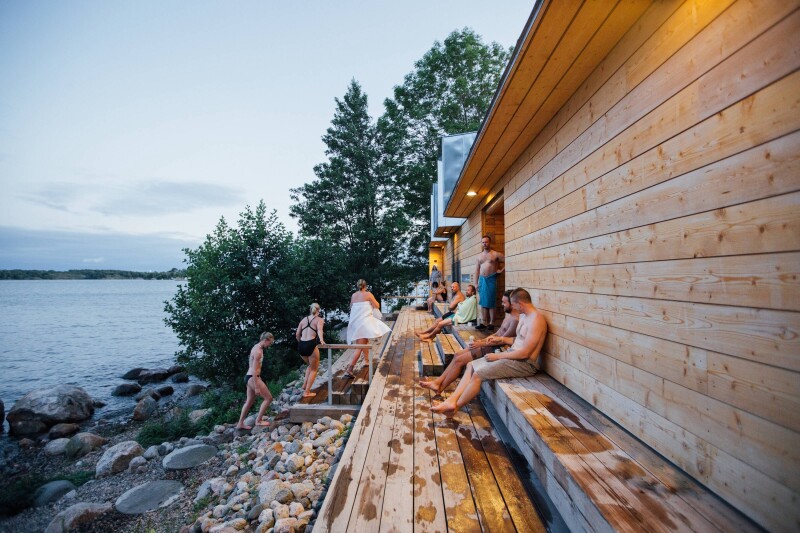Food isn’t just at the center of the table in the Nordic countries. It’s a focal point of life and celebration of community. In Finland, foragers unearth fragrant herbs, berries, and mushrooms with the enigmatic power of umami. Denmark’s imprint is renowned across the globe with Copenhagen’s innovative Noma named the world’s best restaurant several times over. The restaurant redefined contemporary culinary culture with its boundary-pushing, artistic approach. Clean and green went beyond simply “food” to include spiritual sustenance, inspiring generations of chefs to reimagine farm-to-table and fish-to-dish. Today, that legacy lives on throughout Denmark, a leader in sustainability and creativity and Michelin stars.
Eat delicious cuisine from land and sea in Copenhagen

Absalon in central Copenhagen is just one community house where friends (and strangers who will become friends) feast family-style.
Courtesy of Visit Copenhagen/Giuseppe Liverino
“New Nordic” cuisine became global table talk in the early 2000s for its focus on locality and simple presentations that emphasize fresh vegetables over meat—better for those who eat it and the earth. New Nordic continues to evolve and today bright colors and tastes, earthy herbs, pickled vegetables, and techniques that give new life to older methods of smoking, salting, and marinating are easy to find at even the most casual restaurant. There’s no need for a dining jacket for a fine experience; walking shoes are perfectly acceptable at bars, breweries, and gastropubs throughout Copenhagen.
Noma’s legacy lives on in the waterfront neighborhood of Christianshavn, where chef Thorsten Schmidt took over the space to put new spins on classic dishes like Danish frikadeller meatballs at his laid-back restaurant Barr. Locally brewed beers, aquavit, and wine complement what Schmidt calls “Northern Sea cuisine.”

New Nordic restaurants like Copenhagen’s Barr focus on sustainable, local produce and clean flavors that highlight the bounty of Denmark.
Courtesy of Visit Copenhagen/Daniel Rasmussen
The team behind the beloved Bæst and Mirabelle restaurants also recently added a new favorite to the city’s copious choices of natural wine bars. At relaxed Rino VinoFino, guests can pair cheese, charcuterie, and truffle sourdough toast with blind tastings. Those who guess two-thirds of their glass’s grape, producer, or region get their wine on the house. Lead sommelier Marco Bartone describes his team as “advocates for community and camaraderie,” an ethos embodied at the city’s other sustainable restaurants too.
You can find harbor front hygge and sustainable dining at La Banchina in Refshaleoen. Take a dip with your natural wine or coffee during the summer months or relax in the wood-fired sauna come winter before tucking into a steaming plate of local vegetables and fresh fish. (It’s a pescatarian delight, as La Banchina’s no-meat menu includes only what’s foraged and caught from the land and waters surrounding Copenhagen.)
It’s easy to spend most of a day at the waterfront spot but exploring the rest of the Refshaleoen neighborhood is worth it. Microbars, restaurants, and artists’ studios fill the bike-friendly former industrial zone, along with vegetable patches, colorful graffiti, and Reffen—the largest street food market in the Nordics.
Those looking for another city oasis will want to put BaneGaarden at the top of their list. This foodie’s Shangri-La, a 20-minute metro from the city center (or less by bicycle), spans nearly four acres with nine turn-of-the-century barns among verdant vines and flora. An epicurean’s epicenter, the area has food stalls year-round, a summer pop-up restaurant inside the jewel-box greenhouse, and events like concerts, cooking classes, and bingo that highlight community as much as sipping and supping.
Among the most memorable of these is fællesspisning—translated directly, the Danish word means “communal eating.” Dinners, served family-style on large platters at long tables, resemble a more refined picnic with chatter between new friends often continuing long into the night. A host’s job here is just as important as a chef or sommelier in a traditional restaurant since they seat large parties, solo diners, and everything in between to create the optimal amount of conversation.
Foraging in Finland

Detoxifying and immunity-boosting cloudberries are one of the many seasonal delights often found on a foraging adventure in parts of Finland.
Courtesy of Visit Finland/Virpi Mikkonen
Food is as much a recreational and collaborative experience in Finland as it is in Denmark. The forest that blankets 75 percent of the country comes to almost every corner of Helsinki at cozy bistros; most menus are updated as frequently as every two weeks for “micro seasons” and it’s never the same experience twice.
At Natura, the open kitchen is as much entertainment as a metaphor for sharing nature’s bounty and sustainability practices. You can feast on local game and produce farmed within 30 miles of the restaurant. In summer, many of the vegetables and herbs come from Natura’s own farm in the city center. (It’s also not unusual to see home cooks foraging seasonally in pristine Keskuspuisto, Helsinki’s Central Park.)
Come winter, Natura diners can delight in the Finnish traditions of fermenting and pickling which were a vital means of surviving Finland’s chilly winters. Preserving colors and flavors also preserves culture here, and chef David Alberti is among several Michelin-starred Finnish chefs who’ve also earned the guide’s “green star” designation for outstanding sustainability practices.
Eat and relax at Sauna restaurants in Helsinki and beyond

It’s easy to relax and rejuvenate—even in the city center—at one of Helsinki’s Finnish saunas. // Courtesy of Visit Finland/Julia Kivelä
Courtesy of Visit Copenhagen/Julia Kivelä
If you want to unwind while you dine, Finnish sauna restaurants give new meaning to “slow food.” You can spend a whole day alternating between warm saunas and refreshing cold dips at Allas Sea Pool; Lonna, an island easily accessible from Helsinki’s Market Square; or the many other restaurant saunas throughout Finland.
Setting aside time to go further afield allows for more connection with local culture and people, as well as the chance to savor more distinctive flavors. Guided ravinnonhaku foraging experiences bring you to the forest to fill baskets with berries and mushrooms. The bounty, paired with fish from local waters, feeds small groups of 8–12 who feast under a canopy of fragrant bows, a traditional log cabin offering respite from any evening chill. The experience, like so many in Finland and Denmark, is certainly food for thought.












